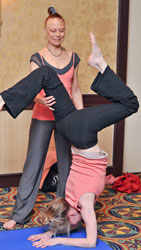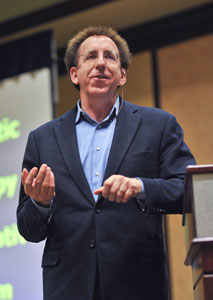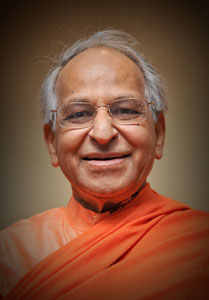Practice Pages: Yoga Therapy
What is Yoga Therapy? by Felicia M. Tomasko, RN
The International Association of Yoga Therapists (IAYT) sponsored their third annual Symposium on Yoga Therapy and Research
(SYTAR) in Los Angeles, March 5 – 8. The weekend featured a historic three-day meeting of the organization’s Council of Schools, where more than forty representatives of various programs training people in the art of applying Yoga therapeutically met to discuss what makes Yoga distinct from Yoga Therapy. The consensus? There was a lot of evaluation along with both agreement and disagreement. Part of the heart of the difference came down to intention: What is the intention of the practice?
In the conference itself, the speakers explored intention, through research presentations, clinical discussions, practice sessions and even enlightening on-stage live case studies with Eric Small, Leslie Kaminoff and Shanti Shanti Kaur Khalsa, all of which demonstrated vastly different and all effective approaches to adapting a practice.
Swami Veda Bharati said something during one of his transmissions of mediation teachings that for me summed up the intention of practice of Yoga Therapy. “Health is equanimity.” Health is the ability to cultivate the faculty of the mind to observe the mind. Health is found in our ability to recognize our mind and our practice, as Swami Veda emphasized, to re-cognize, to tap into the mind. Through this diving in, we find the therapeutic application of the practice and learn to recognize health.
A First Time Attendee’s Impression by Rosabeth Dorfhuber
As a Yoga teacher working with athletes and college students at a Southern California community college, I am interested in how Yoga can help sports-related injuries as well as the health and well-being of those I teach. I was therefore intrigued when I received information on SYTAR; it appeared as if someone had designed a conference especially for me.
My experience started with a preconference musculo-skeletal/structural workshop with a variety of impressive speakers with expertise in different fields. I learned how to perform assessments, as well as beneficial Yoga postures for certain conditions. After this, I had high hopes for the conference.
Dr. Timothy McCall opening address discussing Yoga’s effects on stress lived up to my expectations. My personal observation is that students I’ve taught who are the most stressed and anxious are some of the least flexible physically. Dr. McCall addressed the power of yogic breathing to counter stress in our daily lives. While we may understand that Yoga has beneficial effects of a number of different conditions, the research work of Sat Bir Khalsa, PhD has confirmed what I have heard from my college students and their experience with Yoga helping them to stop smoking, reduce alcohol consumption and feel less anxiety.
Another one of my conference highlights was Dr. Dean Ornish’s keynote address, preceded by a short and relaxing guided meditation led by his wife Anne Ornish. Dr. Ornish’s decades of work which demonstrates that people can stop and even reverse heart disease by making lifestyle changes, which include eating a plant-based diet, practicing Yoga and meditation and participating in support groups, has changed the view of the mainstream medical establishment toward Yoga. During his talk, he presented
new evidence for the effects of Yoga and meditation on positively influencing gene expression. What we once thought to be fixed is now shown to be variable. It’s a fitting analogy for the therapeutic benefit of Yoga.
Rosabeth Dorfhuber is a 200 RYT specializing in teaching yoga to athletes. She has taught yoga to both male and female athletes and teams at the amateur, collegiate and professional levels in many sports including Olympic hopefuls. She also teaches yoga at Santa Barbara City College and is an instructor with Let It Go Yoga Teacher Training and Full Count Fundamentals in Santa Barbara. Contact Rosabeth at rdorfhuber@yahoo.com
Doug Keller Talks Shoulders by Emily Kuser
Yoga therapeutics is far more than musculoskeletal adjustments, but the mechanics of the body is still a vital part of Yoga, and hands-on physical practice sessions integral to the conference. When Doug Keller demonstrated the “disappearing clavicle” oohs and ahhs filled the room as yogis love magic tricks – even more so, we love knowing they’re wisdom, not tricks.
The disappearing clavicle is a visual tool to help us understand proper shoulder placement and correct scapular rhythm. A prevalent
clavicle (collarbone) is a sign of a winged scapula, rolled shoulders, and overall poor posture from the feet up resulting in the unnecessary wear and tear of the shoulder tendons and ligaments.
Take a neutral stance and face a mirror. Roll the shoulders forward and notice the stress building in the thoracic spine from winging the scapulae, and observe the constrictions in the breath. You will see the clavicle protruding from the upper chest. Next, rather than rolling the shoulders up and back, gently slide them back behind you. The clavicle will naturally sit on the top ribs and the scapulae will form their organic shape on the back body. Breathing will become calmer and you will see the clavicle disappear! Check your disappearing clavicles throughout the day to keep your shoulders healthy.
For more information about the International Association of Yoga Therapists, visit: iayt.org
Swami Veda Bharati will be teaching at Rancho La Peurta this summer for two weeks for “A Breath of the Himalayan Tradition,” August 1 -15. rancholapuerta.com
By Various Authors



